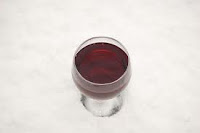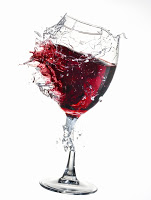With the snow and freezing temperatures we have  been suffering here in the UK with I thought it timely to write about protecting your wine. I heard a horror story recently from a friend where wine froze in his back yard . . . the bottles burst.
been suffering here in the UK with I thought it timely to write about protecting your wine. I heard a horror story recently from a friend where wine froze in his back yard . . . the bottles burst.
Obviously the wines were insured but in the chaos recently deliveries of goods have been making headlines as the country’s roads have become increasingly snowed up.
Wine can survive cold temperatures – which means that everyday drinking wine can be salvageable but if this happens to your fine wines it spells trouble. The exact freezing temperature for wine depends on its alcohol percentage. The  freezing point of wine is generally thought to be about 15ºF (minus 10ºC).
freezing point of wine is generally thought to be about 15ºF (minus 10ºC).
While wine contains alcohol, it’s also mostly water, so when the temperature of the bottle reaches 39°F (4°C) molecules in the water begin to associate with each other in a very precise arrangement.
At 32°F (0°C) a lattice of crystals begins and the fretwork of empty spaces between the crystals means ice takes up more room than water. In fact, ice occupies 1/11 more space than the water from which it was formed.
The expansion of frozen water in wine exerts considerable pressure on the bottle, and the escape route is usually the cork which pops out in response to the pressure. Or the bottle cracks.
If you have eve r resurrected a frozen bottle of wine that you stuck in the freezer and forgot about you will know that if the bottle and cork are intact you can thaw the wine slowly and it will be drinkable.
r resurrected a frozen bottle of wine that you stuck in the freezer and forgot about you will know that if the bottle and cork are intact you can thaw the wine slowly and it will be drinkable.
Obviously I am not advocating this and the only wines I have heard of it happening to are white and not red ones.
This got me thinking about those of us who store wines in our cellars underground. If you are collecting fine wines then provenance and storage are of supreme importance as they can seriously affect your wine if you want to sell it on. Many people have to worry if their wine cellar is too warm.
However, a wine cellar that dips below 40ºF (4ºC) can also harm fragile fine wines. There is some debate about the finer points but normally the idea l wine storage temperature is between 55ºF and 58ºF (13ºC–15ºC). If your wine cellar is affected by cold temperatures you may need to get a system that includes a heater and/or low ambient protection.
l wine storage temperature is between 55ºF and 58ºF (13ºC–15ºC). If your wine cellar is affected by cold temperatures you may need to get a system that includes a heater and/or low ambient protection.
It’s important that wine is kept at a constant temperature – a gradual change between summer and winter of a few degrees won’t matter but if the temperature fluctuates wildly every day it will harm your wines by ageing them more rapidly .
You will be able to spot damage of this nature straight away from the sticky deposit that  often forms around the cork. Over time the continual expansion and contraction of the wine will damage the ‘integrity’ of the cork.
often forms around the cork. Over time the continual expansion and contraction of the wine will damage the ‘integrity’ of the cork.
When this happens, minute quantities of wine may be pushed out along the edge of the cork (between the cork and the bottle neck) allowing air to seep back in.
Once the air is in contact with your wine the irreversible process of oxidation has begun and your wine is ruined. One dead give away of heat damage is colour. A brick red brown colour, especially in a young wine can be an indicator of oxidation damage due to heat. Since Sherry is an oxidised wine, another indicator of heat damage in wines is a sherry-like taste.
Humidity is another essential factor in the cellar – the wrong humidity level can ruin your wine. A relative humidity of 60-80% is an acceptable range with about 70% being considered ideal.
Too much humidity can cause mould to grow on the bottle s. As long as the mould stays on the cork or around the bottle’s lip, this should not affect the wine. Mould may cause label damage, though, which may decrease the resale value of the bottles.
s. As long as the mould stays on the cork or around the bottle’s lip, this should not affect the wine. Mould may cause label damage, though, which may decrease the resale value of the bottles.
Not enough humidity may cause corks to dry and shrink prematurely. This can allow air into the bottle, oxidizing the wine and robbing it of its fruit flavours. In drastic levels of dryness, this damage may cause the ullage (the empty space in the neck of a bottle) to increase.
A quick word about insurance – just because you have a home owner’s policy doesn’t mean that your wine cellar is fully protected (see Protecting Your Investment).
There are companies that offer insurance for your cellared wines and you can either cover the entire cellar or take out cover for individual bottles if they are very valuable. When choosing your insurance, it is important to think about all the potential risks to a wine cellar.
A few years back Chubb Insurance issued a Wine Report based on the observations  of Chubb’s expert appraisers and claims department. It said that amongst the most common risks affecting wine stored in the home were:
of Chubb’s expert appraisers and claims department. It said that amongst the most common risks affecting wine stored in the home were:
Temperature fluctuation – particularly wines held in storage areas which are not appropriate (e.g. garage). Temperature-controlled conditions are required but specialist storage can still be vulnerable to technical faults and power failures.
Water damage – even a small cellar flood can wash off labels and render expensive wine valueless on the market. There is evidence that global warming is increasing the incidence of flooding in the UK and in some areas, notably the London basin, ground water levels have been rising rapidly and affecting cellars.
Humidity – if cellars are too damp mould can affect wine and labels. If too dry, corks will shrink and allow oxidation.


